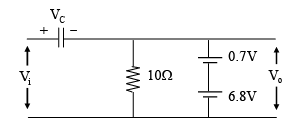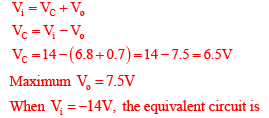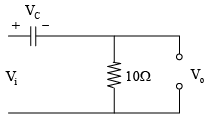Electronics and Communication Engineering (ECE) Exam > Electronics and Communication Engineering (ECE) Questions > In the figure, D1 is a real silicon pn juncti...
Start Learning for Free
In the figure, D1 is a real silicon pn junction diode with a drop of 0.7V under forward bias condition and D2 is a zener diode with breakdown voltage of -6.8 V. The input Vin(t) is a periodic square wave of period T, whose one period is shown in the figure.
Assuming 10t << T. where t is the time constant of the circuit, the maximum and minimum values of the output waveform are respectively,
- a)7.5 V and –20.5V
- b)6.1 V and –21.9V
- c)7.5 V and –21.2 V
- d)6.1 V and –22.6 V
Correct answer is option 'A'. Can you explain this answer?
| FREE This question is part of | Download PDF Attempt this Test |
Verified Answer
In the figure, D1 is a real silicon pn junction diode with a drop of 0...
When Vi = 14V, the equivalent circuit is





|
Explore Courses for Electronics and Communication Engineering (ECE) exam
|

|
Similar Electronics and Communication Engineering (ECE) Doubts
In the figure, D1 is a real silicon pn junction diode with a drop of 0.7V under forward bias condition and D2 is a zener diode with breakdown voltage of -6.8 V. The input Vin(t) is a periodic square wave of period T, whose one period is shown in the figure.Assuming 10t << T. where t is the time constant of the circuit, the maximum and minimum values of the output waveform are respectively,a)7.5 V and –20.5Vb)6.1 V and –21.9Vc)7.5 V and –21.2 Vd)6.1 V and –22.6 VCorrect answer is option 'A'. Can you explain this answer?
Question Description
In the figure, D1 is a real silicon pn junction diode with a drop of 0.7V under forward bias condition and D2 is a zener diode with breakdown voltage of -6.8 V. The input Vin(t) is a periodic square wave of period T, whose one period is shown in the figure.Assuming 10t << T. where t is the time constant of the circuit, the maximum and minimum values of the output waveform are respectively,a)7.5 V and –20.5Vb)6.1 V and –21.9Vc)7.5 V and –21.2 Vd)6.1 V and –22.6 VCorrect answer is option 'A'. Can you explain this answer? for Electronics and Communication Engineering (ECE) 2024 is part of Electronics and Communication Engineering (ECE) preparation. The Question and answers have been prepared according to the Electronics and Communication Engineering (ECE) exam syllabus. Information about In the figure, D1 is a real silicon pn junction diode with a drop of 0.7V under forward bias condition and D2 is a zener diode with breakdown voltage of -6.8 V. The input Vin(t) is a periodic square wave of period T, whose one period is shown in the figure.Assuming 10t << T. where t is the time constant of the circuit, the maximum and minimum values of the output waveform are respectively,a)7.5 V and –20.5Vb)6.1 V and –21.9Vc)7.5 V and –21.2 Vd)6.1 V and –22.6 VCorrect answer is option 'A'. Can you explain this answer? covers all topics & solutions for Electronics and Communication Engineering (ECE) 2024 Exam. Find important definitions, questions, meanings, examples, exercises and tests below for In the figure, D1 is a real silicon pn junction diode with a drop of 0.7V under forward bias condition and D2 is a zener diode with breakdown voltage of -6.8 V. The input Vin(t) is a periodic square wave of period T, whose one period is shown in the figure.Assuming 10t << T. where t is the time constant of the circuit, the maximum and minimum values of the output waveform are respectively,a)7.5 V and –20.5Vb)6.1 V and –21.9Vc)7.5 V and –21.2 Vd)6.1 V and –22.6 VCorrect answer is option 'A'. Can you explain this answer?.
In the figure, D1 is a real silicon pn junction diode with a drop of 0.7V under forward bias condition and D2 is a zener diode with breakdown voltage of -6.8 V. The input Vin(t) is a periodic square wave of period T, whose one period is shown in the figure.Assuming 10t << T. where t is the time constant of the circuit, the maximum and minimum values of the output waveform are respectively,a)7.5 V and –20.5Vb)6.1 V and –21.9Vc)7.5 V and –21.2 Vd)6.1 V and –22.6 VCorrect answer is option 'A'. Can you explain this answer? for Electronics and Communication Engineering (ECE) 2024 is part of Electronics and Communication Engineering (ECE) preparation. The Question and answers have been prepared according to the Electronics and Communication Engineering (ECE) exam syllabus. Information about In the figure, D1 is a real silicon pn junction diode with a drop of 0.7V under forward bias condition and D2 is a zener diode with breakdown voltage of -6.8 V. The input Vin(t) is a periodic square wave of period T, whose one period is shown in the figure.Assuming 10t << T. where t is the time constant of the circuit, the maximum and minimum values of the output waveform are respectively,a)7.5 V and –20.5Vb)6.1 V and –21.9Vc)7.5 V and –21.2 Vd)6.1 V and –22.6 VCorrect answer is option 'A'. Can you explain this answer? covers all topics & solutions for Electronics and Communication Engineering (ECE) 2024 Exam. Find important definitions, questions, meanings, examples, exercises and tests below for In the figure, D1 is a real silicon pn junction diode with a drop of 0.7V under forward bias condition and D2 is a zener diode with breakdown voltage of -6.8 V. The input Vin(t) is a periodic square wave of period T, whose one period is shown in the figure.Assuming 10t << T. where t is the time constant of the circuit, the maximum and minimum values of the output waveform are respectively,a)7.5 V and –20.5Vb)6.1 V and –21.9Vc)7.5 V and –21.2 Vd)6.1 V and –22.6 VCorrect answer is option 'A'. Can you explain this answer?.
Solutions for In the figure, D1 is a real silicon pn junction diode with a drop of 0.7V under forward bias condition and D2 is a zener diode with breakdown voltage of -6.8 V. The input Vin(t) is a periodic square wave of period T, whose one period is shown in the figure.Assuming 10t << T. where t is the time constant of the circuit, the maximum and minimum values of the output waveform are respectively,a)7.5 V and –20.5Vb)6.1 V and –21.9Vc)7.5 V and –21.2 Vd)6.1 V and –22.6 VCorrect answer is option 'A'. Can you explain this answer? in English & in Hindi are available as part of our courses for Electronics and Communication Engineering (ECE).
Download more important topics, notes, lectures and mock test series for Electronics and Communication Engineering (ECE) Exam by signing up for free.
Here you can find the meaning of In the figure, D1 is a real silicon pn junction diode with a drop of 0.7V under forward bias condition and D2 is a zener diode with breakdown voltage of -6.8 V. The input Vin(t) is a periodic square wave of period T, whose one period is shown in the figure.Assuming 10t << T. where t is the time constant of the circuit, the maximum and minimum values of the output waveform are respectively,a)7.5 V and –20.5Vb)6.1 V and –21.9Vc)7.5 V and –21.2 Vd)6.1 V and –22.6 VCorrect answer is option 'A'. Can you explain this answer? defined & explained in the simplest way possible. Besides giving the explanation of
In the figure, D1 is a real silicon pn junction diode with a drop of 0.7V under forward bias condition and D2 is a zener diode with breakdown voltage of -6.8 V. The input Vin(t) is a periodic square wave of period T, whose one period is shown in the figure.Assuming 10t << T. where t is the time constant of the circuit, the maximum and minimum values of the output waveform are respectively,a)7.5 V and –20.5Vb)6.1 V and –21.9Vc)7.5 V and –21.2 Vd)6.1 V and –22.6 VCorrect answer is option 'A'. Can you explain this answer?, a detailed solution for In the figure, D1 is a real silicon pn junction diode with a drop of 0.7V under forward bias condition and D2 is a zener diode with breakdown voltage of -6.8 V. The input Vin(t) is a periodic square wave of period T, whose one period is shown in the figure.Assuming 10t << T. where t is the time constant of the circuit, the maximum and minimum values of the output waveform are respectively,a)7.5 V and –20.5Vb)6.1 V and –21.9Vc)7.5 V and –21.2 Vd)6.1 V and –22.6 VCorrect answer is option 'A'. Can you explain this answer? has been provided alongside types of In the figure, D1 is a real silicon pn junction diode with a drop of 0.7V under forward bias condition and D2 is a zener diode with breakdown voltage of -6.8 V. The input Vin(t) is a periodic square wave of period T, whose one period is shown in the figure.Assuming 10t << T. where t is the time constant of the circuit, the maximum and minimum values of the output waveform are respectively,a)7.5 V and –20.5Vb)6.1 V and –21.9Vc)7.5 V and –21.2 Vd)6.1 V and –22.6 VCorrect answer is option 'A'. Can you explain this answer? theory, EduRev gives you an
ample number of questions to practice In the figure, D1 is a real silicon pn junction diode with a drop of 0.7V under forward bias condition and D2 is a zener diode with breakdown voltage of -6.8 V. The input Vin(t) is a periodic square wave of period T, whose one period is shown in the figure.Assuming 10t << T. where t is the time constant of the circuit, the maximum and minimum values of the output waveform are respectively,a)7.5 V and –20.5Vb)6.1 V and –21.9Vc)7.5 V and –21.2 Vd)6.1 V and –22.6 VCorrect answer is option 'A'. Can you explain this answer? tests, examples and also practice Electronics and Communication Engineering (ECE) tests.

|
Explore Courses for Electronics and Communication Engineering (ECE) exam
|

|
Suggested Free Tests
Signup for Free!
Signup to see your scores go up within 7 days! Learn & Practice with 1000+ FREE Notes, Videos & Tests.























